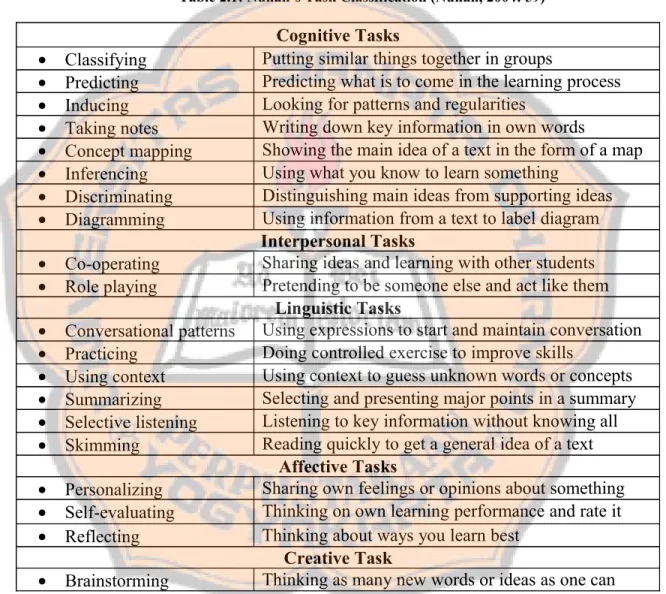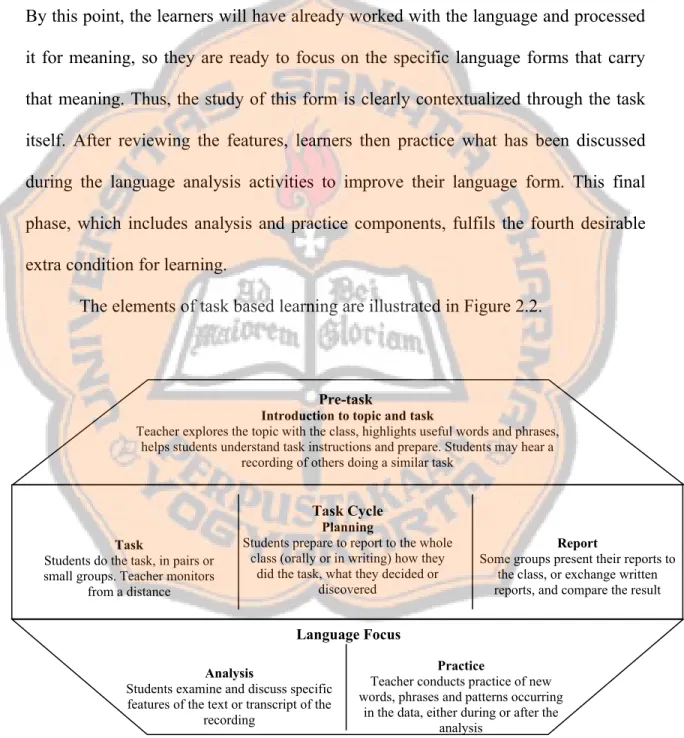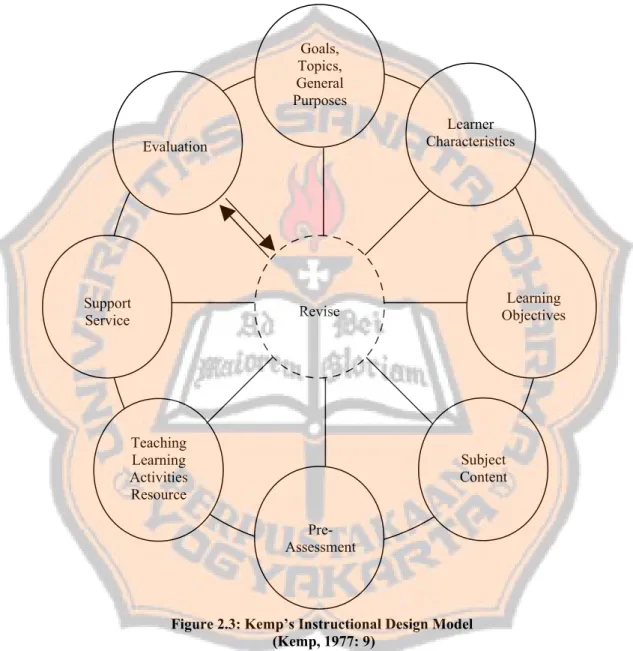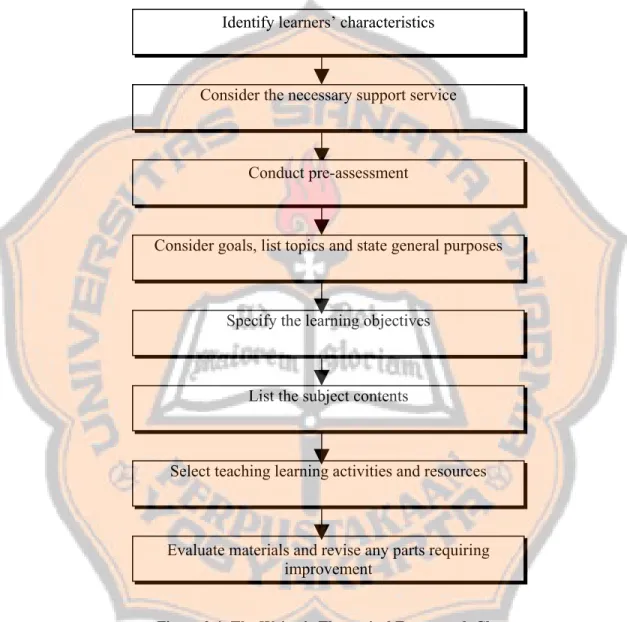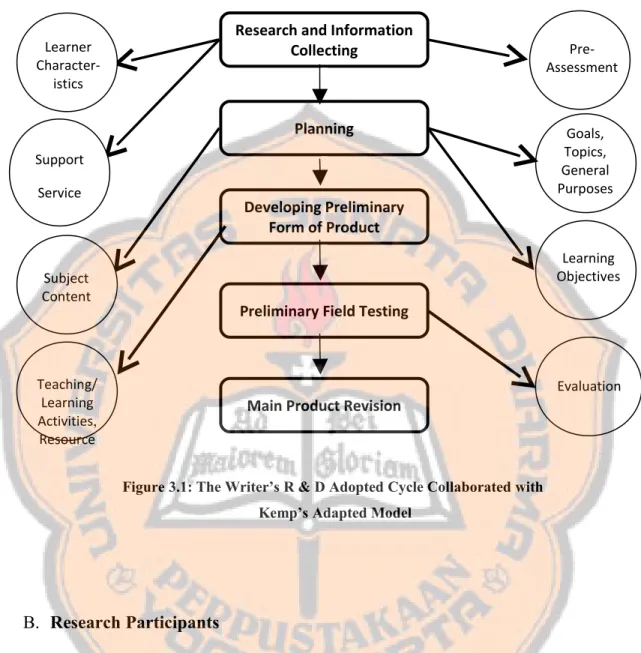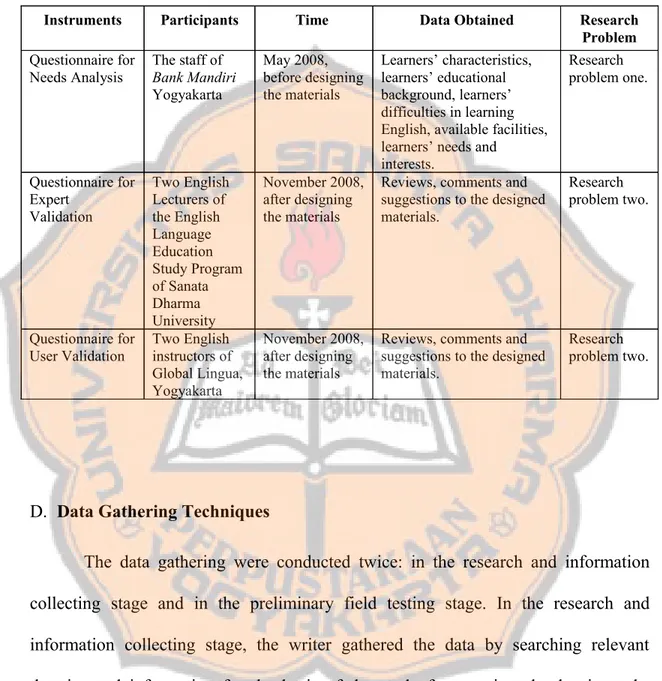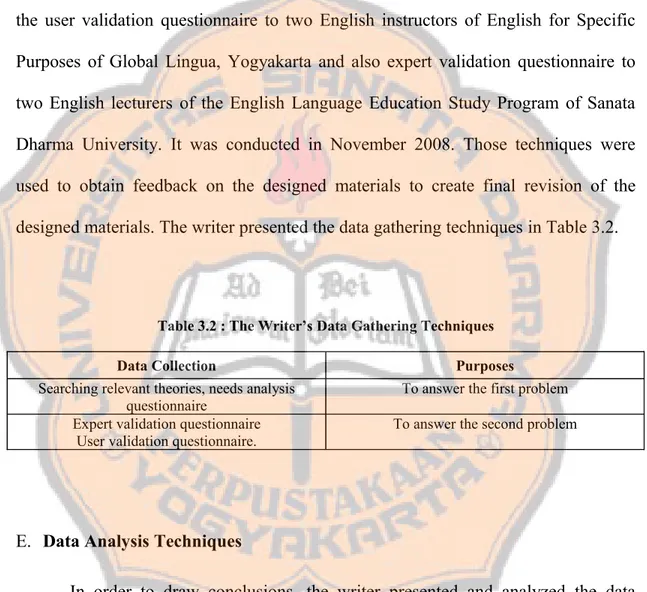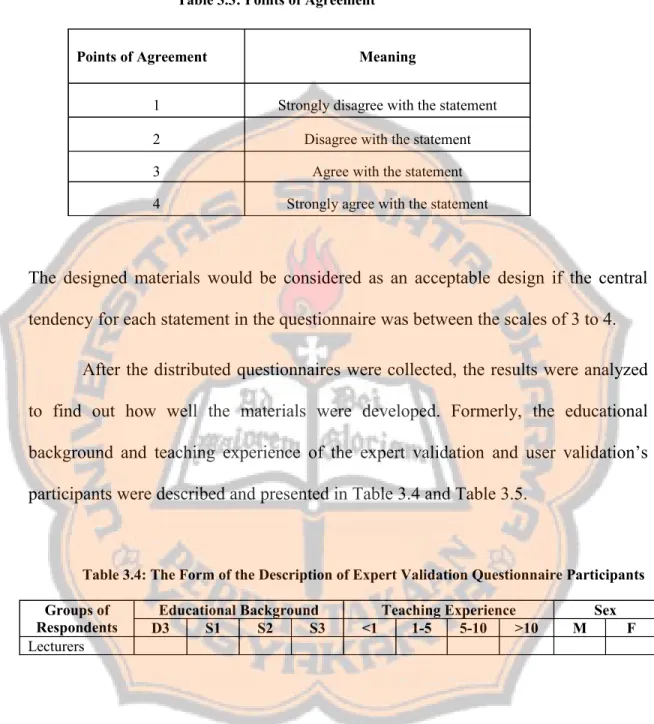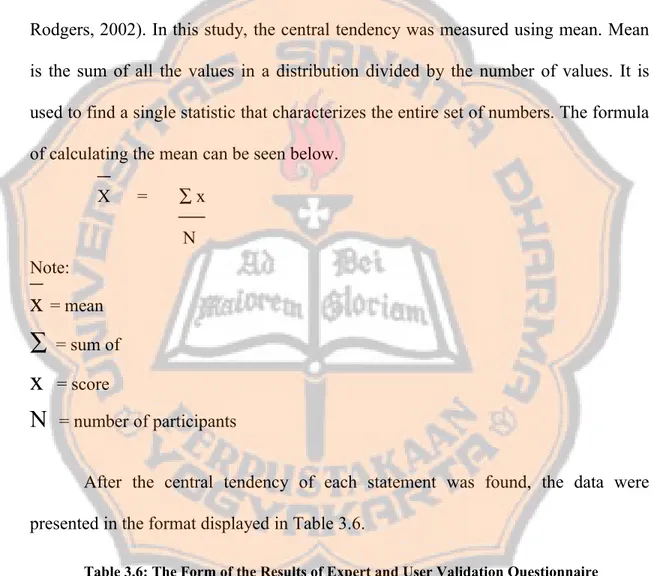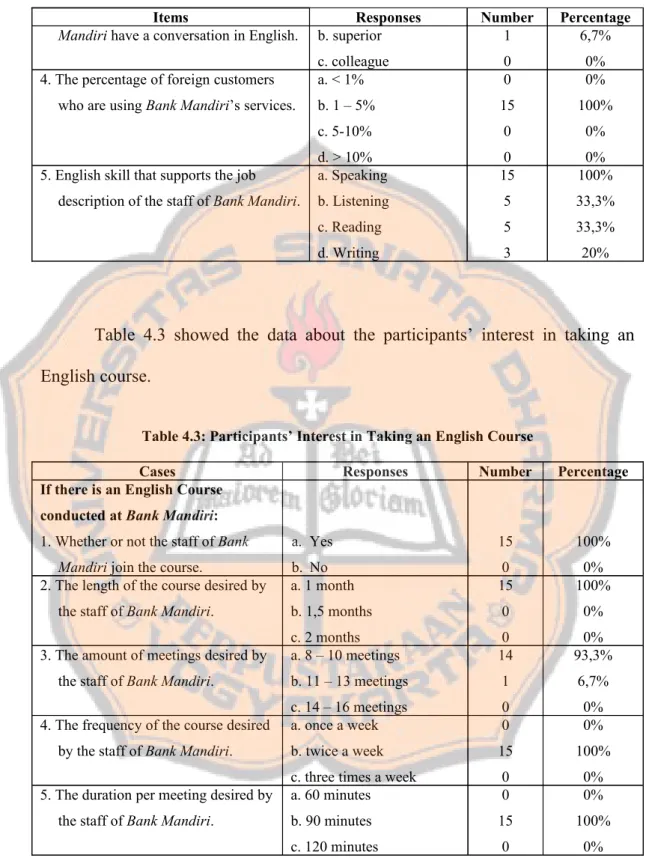i
ENGLISH INSTRUCTIONAL SPEAKING MATERIALS USING TASK BASED LEARNING
FOR THE STAFF OF BANK MANDIRI YOGYAKARTA
A THESIS
Presented as Partial Fulfillment of the Requirements to Obtain the Sarjana Pendidikan Degree
in English Language Education
By
Patricia Angelina Lasut Student Number: 041214017
ENGLISH LANGUAGE EDUCATION STUDY PROGRAM DEPARTMENT OF LANGUAGE AND ARTS EDUCATION FACULTY OF TEACHERS TRAINING AND EDUCATION
SANATA DHARMA UNIVERSITY YOGYAKARTA
ABSTRACT
Angelina Lasut, Patricia. 2009. English Instructional Speaking Materials Using Task Based Learning for the Staff of Bank Mandiri Yogyakarta. Yogyakarta: English Education Study Program, Sanata Dharma University.
Bank Mandiri as one of the well-reputed banks in Indonesia has realized the importance of English mastery for their staff. Bank Mandiri had asked for an English course that would suit their needs. Most of the staff of Bank Mandiri in Yogyakarta have some difficulties to communicate with the foreign customers, which hinder the process of the service. Therefore, this study attempted to develop English instructional speaking materials for the staff of Bank Mandiri in Yogyakarta using the principles of task-based learning.
This study was aimed to find out the answers of the following two research questions: (a) how English instructional speaking materials using task-based learning for the staff of Bank Mandiri Yogyakarta are designed, and (b) what the designed materials look like.
To answer the first problem, the writer adapted Kemp’s instructional design model (1977) comprising eight flexible, interdependent steps. Those steps, subsequently, were put under the umbrella of Borg & Gall’s (1986) Research and Development (R&D) method. Due to time and resource limitations, only five out of ten steps of the R&D model were employed, which were: (1) Research and information collecting, (2) Planning, (3) Developing preliminary form of product, (4) Preliminary field testing, and (5) Main product revision.
To acquire required information for developing the materials, the writer distributed needs analysis questionnaire to twenty staff of Bank Mandiri, Yogyakarta. After the materials were designed, expert validation and user validation questionnaire were distributed to two instructors and two lecturers to obtain feedback and evaluation on the designed materials. The evaluation results showed that the materials were well-designed and applicable, indicated by the means ranging from 3.25 to 4.00 from the scale of 1 to 4. Five suggestions were accepted to revise the materials: adding instructions in every section of the unit, changing the phrase “Don’t Stop Now!” into “Prepare Yourself!”, numbering each activity contained in each section, adding the teaching and learning media, evaluation and references, and stating explicitly the aim of “It’s Time to Write” in the overview of the materials.
To answer the second question, the writer presented the revised version of the designed materials. The materials covered eight units. Each unit consisted of five sections, namely “Do You Remember?”, “Prepare Yourself!”, “Can You Do These?”, “Let’s Learn!”, and “It’s Time to Write”.
In conclusion, due to its means ranging from 3.25 to 4.00, the designed materials were considered well-developed and ready to be used by the staff of Bank Mandiri Yogyakarta. Lastly, it was expected that the materials could improve the speaking skill of the staff of Bank Mandiri Yogyakarta.
ABSTRAK
Angelina Lasut, Patricia. 2009. English Instructional Speaking Materials Using Task Based Learning for the Staff of Bank Mandiri Yogyakarta. Yogyakarta: Program Studi Pendidikan Bahasa Inggris, Universitas Sanata Dharma.
Bank Mandiri sebagai salah satu bank yang mempunyai reputasi baik di Indonesia telah menyadari pentingnya penguasaan Bahasa Inggris bagi staff mereka. Bank Mandiri meminta diadakannya kursus Bahasa Inggris yang sesuai dengan kebutuhan mereka. Banyak dari staff Bank Mandiri Yogyakarta mengalami kesulitan untuk berkomunikasi dengan pelanggan asing, dan hal tersebut menghalangi proses pelayanan. Oleh karena itu, penelitian ini mencoba untuk mengembangkan materi instruksional Bahasa Inggris Speaking untuk staff Bank Mandiri Yogyakarta menggunakan prinsip task-based learning.
Penelitian ini bertujuan untuk mencari jawaban dari 2 rumusan masalah berikut ini: (a) Bagaimanakah materi instruksional Bahasa Inggris Speaking menggunakan task-based learning untuk staff Bank Mandiri Yogyakarta dirancang?, dan (b) Bagaimanakah penyajian materi Speaking yang telah disusun tersebut?.
Untuk menjawab masalah pertama, penulis mengadaptasi model perancangan instruksional yang dikembangkan oleh Kemp (1977) yang mencakup delapan langkah yang saling bergantung dan fleksibel. Langkah-langkah tersebut kemudian diletakkan di bawah kerangka metode Educational Research and Developmet (R & D) Borg dan Gall (1986). Oleh karena keterbatasan waktu dan sumber, hanya lima dari sepuluh langkah dari model R & D yang digunakan, yaitu: (1) Penelitian dan pengumpulan informasi, (2) Perencanaan, (3) Pengembangan bentuk awal produk, (4) Pengujian awal di lapangan, dan (5) Revisi produk.
Untuk mendapatkan informasi yang dibutuhkan guna mengembangkan materi, penulis menyebarkan kuesioner analisis kebutuhan kepada dua puluh orang staff Bank Mandiri Yogyakarta. Setelah materi selesai disusun, kuesioner untuk validasi ahli dan validasi pengguna diberikan kepada dua instruktor dan dua dosen guna mendapatkan masukan dan evaluasi terhadap materi yang telah disusun. Hasil evaluasi menunjukkan bahwa materi telah disusun dengan baik dan dapat digunakan, yang diindikasikan oleh nilai rata-rata yang berkisar anara 3.25 sampai 4.00 dari skala 1-5. Lima macam saran diterima untuk merevisi materi: menambah instruksi di setiap seksi unit, mengubah frase “Don’t Stop Now!” menjadi “Prepare Yourself!”, memberi nomor pada setiap aktivitas yang ada di dalam tiap seksi, menambahkan sarana pengajaran dan pembelajaran, evaluasi dan referensi, serta menyatakan secara eksplisit tujuan dari “It’s Time to Write” pada ikhtisar materi.
Untuk menjawab pertanyaan kedua, penulis menyertakan materi yang telah disusun setelah revisi. Materi mencakup delapan unit. Setiap unit terdiri dari lima seksi, yaitu “Do You Remember?”, “Prepare Yourself!”, “Can You Do These?”, “Let’s Learn!”, dan “It’s Time to Write”.
Sebagai kesimpulan, karena nilai rata-rata yang berkisar antara 3.25 sampai 4.00, materi yang telah disusun dianggap telah dikembangkan dengan baik dan siap untuk digunakan oleh staff Bank Mandiri Yogyakarta. Akhir kata, diharapkan bahwa materi tersebut dapat meningkatkan kemampuan Speaking staff Bank Mandiri Yogyakarta.
ACKNOWLEDGEMENTS
First and foremost, I would like to express my gratitude to my Lord, Jesus Christ, for His mercy, guidance, and blessings so that I was able to finish my
thesis. He always makes a way when there seems to be no way. There is nothing impossible in Him.
Next, I would like to address my sincere gratitude to my major sponsor, Christina Kristiyani, S.Pd., M.Pd. and my co-sponsor Made Frida Yulia, S.Pd., M.Pd. for their willingness to share their knowledge and expertise. They
have been extraordinary in their invaluable supports, criticism, and suggestions to my thesis. In addition, I am very grateful to Drs. J. B. Gunawan, M. A. and Gregorius Punto Aji, S. Pd., M. Hum. for willingly spending their time evaluating my designed materials.
I warmly thank the English instructors of Global Lingua Yogyakarta, Ms. Doktrin and Ms. Siska, for their help, guidance, as well as useful suggestions to my designed materials.
I am deeply grateful to all lecturers of the English Language Education Study Program of Sanata Dharma University for their guidance, dedication, and knowledge they have shared for the past four years. I also thank Mbak Danik and Mbak Tari for their countless service and help during my study.
I wish to thank all my classmates for willingly sharing the joy and spirit during my study in this university. I am very grateful to the following for their help in the finishing of my thesis: Oktavianus Gresasis Primantoro Putro,
Agnes Nora, Antonius Jody, Chrysogonus Siddha, Kevin Bain, Billy
Gunterman, Arsita Nindya, Yosepha Rini, Vina Andriani, Anggraeni Suryana, Melania Setyorini and Theresia Vina. In addition, I warmly thank my
best friends: Sukma, Cahya, Riana, Bertha, Risa, Elly, Oon, Icha, Mietha, Christina, Tya, Joni, Adit, Yason, Aan, Pak De, Elizt, Lin-Lin, Bambang, Bram, Yosan and Harris for their precious friendship. I also thank the people
who are special for me, my students and also my true friends: Aldy Christianto, Adi Nugroho, Justin Jaya, Ferry Haryono, Jeffry Alexandra and Shafura Febriana for their endless support and care.
I dedicate this thesis to Melly Nangoi, my beloved mother, for her endless love and support. I am very grateful to my mother for her irreplaceable care and advice. She always inspires me to live this life sincerely and grow through the pain. I am also very grateful to my sister Kresentia Elizabeth Lasut for her countless help and support.
Lastly, I would like to apologize if I have inadvertently omitted anyone to whom the appreciation is due.
Patricia A. L.
TABLE OF CONTENTS
Page
TITLE PAGE ... i
APPROVAL PAGES ... ii
STATEMENT OF WORK’S ORIGINALITY ...iv
ABSTRACT ...v
ABSTRAK...vi
ACKNOWLEDGEMENTS ...viii
TABLE OF CONTENTS ...x
LIST OF TABLES ... xv
LIST OF FIGURES ...xvii
LIST OF APPENDICES ……….xviii
CHAPTER I: INTRODUCTION A. Background of the Study……… 1
B. Problem Formulation……….………. 4
C. Problem Limitation……….………… 4
D. Purposes of the Study ……….………... 4
E. Benefits of the Study……….…………. 5
F. Definitions of Terms………..………. 6
1. Instructional Materials...………..………. 6
2. Speaking……….….………. 6
3. Task………6
4. Task Based Learning………..7
5. The Staffs of Bank Mandiri………7
CHAPTER II: THEORETICAL REVIEW A. Theoretical Review……….…………..8
1. English for Specific Purposes (ESP)………...8
2. Speaking………10
a. Nature of Speaking……….……...………10
b. Principles for Teaching Speaking……….……...…………..11
3. Task Based Learning……….………...…………..11
a. Definition of Task Based Learning………….………...11
b. Types of Tasks……….…………..13
c. Framework of Task Based Learning……….……….17
d. Learner’s Roles in Task Based Learning………....……...20
e. Teacher’s Roles in Task Based Learning……….….……...21
4. Journals in Language Teaching and Learning……….………..22
5. Material Adaptation ……….……….…24
a. Definition……….….….24
b. Principles of Materials Adaptation………..…..25
c. Techniques for Materials Adaptation………..…..25
6. Instructional Design Model……….…..26
B. Theoretical Framework……….…..31
CHAPTER III: METHODOLOGY A. Method of the Study………36
1. Research and Information Collecting………38
2. Planning……….38
3. Development of Preliminary Form of Product………..39
4. Preliminary Field Testing………..39
5. Main Product Revision………..40
B. Research Participants..……….42
1. Research and Information Collecting Participants ………...43
2. Preliminary Field Testing Participants ……….43
C. Research Instruments………...44
D. Data Gathering Techniques………..46
E. Data Analysis Techniques………47
1. Needs Analysis Questionnaire………48
2. Expert Validation and User Validation Questionnaire……….……….48
F. Research Procedures……….51
CHAPTER IV: RESULTS AND DISCUSSION
A. Process of Designing English Instructional Speaking Materials ………….53
1. Research and Information Collecting………..53
a. Learners’ Characteristics………53
b. Pre-Assessment………...59
c. Support Services……….61
2. Planning………..61
a. Stating Goals, Topics and General Purposes ……….61
b. Specifying the Learning Indicators ………63
c. Listing and Organizing Subject Contents ………..65
3. Developing Preliminary Form of Product …...………..66
4. Preliminary Field Testing………...71
5. Main Product Revision………...77
B. The Presentation of the English Instructional Speaking Materials for Bank Mandiri Yogyakarta ………... 79
CHAPTER V: CONCLUSIONS AND SUGGESTIONS A. Conclusions………..82
B. Suggestions………..85
1. Suggestions for Material Users………..85
2. Suggestions for Future Research………85
REFERENCES ………..87
APPENDICES………90
LIST OF TABLES
Table Page
2.1 Nunan’s Task Classification………..16
3.1 The Writer’s Data Collection.…..………. 46
3.2 The Writer’s Data Gathering Techniques………...…...47
3.3 Points of Agreement ……….………49
3.4 The Form of the Description of Expert Validation Questionnaire Participants ………..49
3.5 The Form of the Description of User Validation Questionnaire Participants …………...………..49
3.6 The Form of the Results of Expert and User Validation Questionnaire………...….50
4.1 Data of the Participants ..………..………54
4.2 The Importance of English for the Staffs of Bank Mandiri ………..54
4.3 Participants’ Interest in Taking an English Course …….……….55
4.4 Teaching Learning Media and Activities ……….56
4.5 The Results of the Chosen Topics ………58
4.6 Necessities, Lacks and Wants of the Learners …...………...…...59
4.7 Educational Background ………..59
4.8 Difficulties in Communicating Using English ……….... 60
4.9 The Learning Topics of the Materials………...………62
4.10 The General Purposes………...63
4.11 The Learning Indicators of the Materials……….…….64
4.12 The Organization of Subject Contents……….….66
4.13 The Description of Participants for Expert Validation Questionnaire…..72
4.14 The Description of Participants for User Validation Questionnaire ...72
4.15 The Results of the Questionnaire for Expert Validation
and User Validation ………...……… 73
4.16 The Results of Essay Questions ………. 76
5.1 The Arrangement of the Materials ………. 84
LIST OF FIGURES
Figure Page
2.1 The Branch of English Language Teaching………..…………...……9
2.2 Willis’s Task-based Learning Framework ………19
2.3 Kemp’s Instructional Design Model...27
2.4 The Writer’s Theoretical Framework Chart ...35
3.1 The Writer’s R & D Adopted Cycle Collaborated with Kemp’s Adapted Model ...42
LIST OF APPENDICES
Appendix Page
Appendix A: Questionnaire for Needs Analysis ……… 91 Appendix B: Questionnaire for Expert Validation and User Validation …….97 Appendix C: The Results of the Questionnaire
for Expert Validation and User Validation ………..101 Appendix D: Teacher’s Guide………. ..104 Appendix E: The Final Version of the Designed Materials………...153
CHAPTER I INTRODUCTION
This chapter elaborates six essential parts of this study: background of the
study, problem formulation, problem limitation, purposes of the study, benefits of the
study, and definitions of terms.
A. Background of the Study
As a developing country, Indonesia is expanding many fields of work to an
international scale, which automatically forces companies to keep up with the
demands. Thus, many companies are now trying to increase their staff’s competence
in English.
Banks are also the ones that demand their staff to be more competent in
English. The ability to master English is crucial for the bank staff because they deal
with the customers directly. Bank Mandiri as one of the well-reputed banks in Indonesia has realized the importance of English mastery for their staff and has
wanted to improve their English competence by conducting an English course.
The writer chooses the staff of Bank Mandiri as the participants because of two reasons: Bank Mandiri asks the writer for an English course that will suit their needs and the writer also has an access to conduct the needs analysis and the process
Most of the staff of Bank Mandiri Yogyakarta have some difficulties to communicate with the foreign customers who visit the bank. These difficulties hinder
the process of the service. Based on that, it is clear that English speaking ability is
needed and is important for them in order to provide the best service to the customers.
Considering the fact that they have very limited time to study English because
of their work, it can be concluded that it will be very difficult for them to learn
English from the basic level. Therefore, the most appropriate materials for them are
the materials that are practical and applicable to their working situation. This
emergence of English learning needs in the working fields prompts the writer to
design English learning materials based on the needs and interests in the target
situation which the learners experience.
In other words, English for Specific Purposes (ESP), particularly English for
Banking, is the one that suits their needs best. ESP is an approach which is based on
the learners’ needs. It means that all the decisions related to the designing of the
materials will be based on the learners’ needs and interests. The result of ESP is a
kind of materials that match directly with the condition that they are going to
encounter in their working field.
This study is important because it aims to present appropriate materials to
help the staff of Bank Mandiri Yogyakarta in particular to improve their English speaking ability. By providing the materials which are practical and applicable to
their working field, they will be able to communicate with foreign customers well and
level, which is highly impossible due to their heavy working hours, to fulfill the
increasing demands of having good English competence.
The main point of task based learning lies in the experiential learning in which
the learner’s prior experience becomes the starting point which will improve along
with the task completion in the classroom. By doing the tasks, learners will be
exposed to the target language. When the learners encounter problems, they will be
involved in the discussion which will broaden their opportunity to use the target
language. They will also have the chance to fill in the gaps in their language
competence through the feedback in the discussion; which will improve their
language mastery. Furthermore, tasks are also said to be motivational, as they require
learners to use authentic language, vary in format and operation, often include
physical activities, involve partnership and collaboration, may call on learners’ past
experience and tolerate as well as encourage a variety of communication styles
(Richards and Rodgers, 2001).
Hence, this study intends to design English instructional speaking materials
for the staff of Bank Mandiri Yogyakarta using task based learning. Since the biggest difficulty that the staff of Bank Mandiri Yogyakarta experience is to communicate with the foreign customers who visit the bank, the designed materials will be focusing
B. Problem Formulation
This study aims to answer two problems in order to present English
instructional speaking materials using task based learning for the staff of Bank Mandiri Yogyakarta. They are stated into two questions:
1. How are English instructional speaking materials using task-based learning
for the staff of Bank Mandiri Yogyakarta designed?
2. What do English instructional speaking materials using task-based learning
for the staff of Bank Mandiri Yogyakarta look like?
C. Problem Limitation
In order to enable an in-depth study, the scope of this study has to be
narrowed by some limitations. Firstly, this study focuses on designing English
instructional materials on speaking ability. Secondly, this study focuses on designing
speaking materials for the staff of Bank Mandiri Yogyakarta. Finally, the pedagogical methodology underlying the designed materials is task based learning.
D. Purposes of the Study
The purposes of this study are to answer the questions stated previously on the
problem formulation. The purposes of the study are as follows:
1. The study aims to find out how English instructional speaking materials using
2. The study aims to present English instructional speaking materials using
task-based learning for the staff of Bank Mandiri Yogyakarta.
E. Benefits of the Study
The results of this study are expected to be beneficial for the staff of Bank Mandiri as well as the future researchers in particular, and for the English instructors for bank employees and the staff of other banks in general.
1. The staff of Bank Mandiri
The designed materials are expected to be helpful for the staff of Bank Mandiri to facilitate them in learning English in a motivational and meaningful way, so that they will be able to improve their speaking ability to communicate with
foreign customers.
2. The instructors for bank employees
The writer hopes that the designed materials may enrich their teaching
resources, so that they will have more alternatives to apply in their teaching-learning
activities.
3. The future researchers
The results of this study can be used to carry out another study on English for
specific purposes. The materials can be used as references in designing further
materials. They can implement the designed materials to see whether the materials are
F. Definitions of Terms
In order to have a clear understanding of the study, the writer includes the
definitions of some important terms. The definitions are as follows:
1. Instructional Materials
Instructional materials are defined as a set of units that are used by teachers
and learners as the focus of the discussion in the teaching learning process. It could
help teachers and learners to organize the teaching and learning process and to
provide a stimulus to learning (Briggs, 1987). In this study, instructional materials
refer to materials which are used to facilitate teaching and learning process. They
allow the students to interact and focus on the discussion so that they could develop
their speaking skill.
2. Speaking
According to Clark and Clark (1977), speaking is an instrumental activity in
which speakers talk in order to have some effects on their listeners. In speaking, a
message is transferred from a speaker to a hearer. The speaker produces the message
and the hearer receives the message. Speaking is considered accomplished when both
the speaker and the hearer exchange their knowledge, thoughts and feelings. In this
study, speaking is a productive skill used in order to convey meaning to make the
listeners understand what the speakers mean.
3. Task
According to Willis (1996), a task is a meaningful activity in which learners
outcome or goal, rather than to focus on the language form. In this study, a task is an
activity that requires learners to use the target language in a meaningful way.
4. Task-based Learning
Task based learning refers to a pedagogical approach derived from
communicative language teaching approach, which utilizes the use of language tasks
as the central key in learning (Richards and Rodgers, 2001). In this study, task based
learning is a method that uses tasks for learning.
5. The Staff of Bank Mandiri
The staff of Bank Mandiri are defined as a group of Bank Mandiri employees whose positions are as the Security, Customer Service Officer, Teller, Financial
CHAPTER II
THEORETICAL REVIEW
This chapter discusses the theories which support this study. It consists of two
sections: theoretical review and theoretical framework. The first section discusses the
English for Specific Purposes, Speaking, Task Based Learning, Materials Adaptation,
Instructional Design Models, and Journals in Language Teaching. Meanwhile, the
second section elaborates the framework synthesized from the discussed theories.
A. Theoretical Review
In this section, the writer discusses some theories of designing the speaking
materials. This part provides the information relevant to the study, which will be used
as a foundation for the writer to design the instructional speaking materials using
task-based learning.
1. English for Specific Purposes (ESP)
The staff of Bank Mandiri Yogyakarta have very limited time to study English
because of their work. Consequently, it will be very difficult for them to learn English
from the beginning. Therefore, the most appropriate materials for them are the
materials that are practical and applicable to their working situation. In other words,
English for Specific Purposes (ESP), particularly English for Banking, is the one that
learners’ needs. It means that all the decisions in deciding the materials will be based
on the learners’ needs. The result of ESP is a kind of materials that match directly
with the condition that they are going to encounter in their working field. Hutchinson
and Waters (1987) divided ESP into two main types according to the reasons why the
learners require English for. They are English for Academic Purposes (EAP) and
English for work or training (EOP/EVP/VESL: English for Occupational
Purposes/English for Vocational Purposes/Vocational English as a Second
Language). They propose the branch of English language teaching based on the
learners’ purpose as seen in Figure 2.1.
English Language Teaching
Fig
ure 2.1: The Branch of English Language Teaching
(Hutchinson and Waters, 1994)
General English (GE)
English for Specific Purposes (ESP)
English for Occupational Purposes (EOP) English for Academic
Purposes (EAP)
English for banking English as LT 1
(EMT)
English as Foreign Language
The writer should be aware of the branch of English language teaching before
designing the materials. English for banking is included into the EFL, in which there
is very little opportunities to use the target language outside the classroom. Therefore,
the context will be different from designing materials for ESL, in which the target
language is used for daily communication in society.
There is also another thesis on designing English materials for banking staff.
It was made by Veronica Widi Handoyowati (2004). This previous thesis used
Communicative Language Teaching approach, while this thesis focuses on using
Task Based Learning.
Since the designed materials will be focusing on the speaking skill, it is also
important to know the theories related to the teaching of speaking.
2. Speaking
Speaking is the main skill that will be learned in this study. Therefore, it is
important for the writer to know about speaking in depth.
a. Nature of Speaking
Speaking is one of the four basic skills, along with listening, reading and
writing. Speaking and writing are classified as active or productive skills whereas
listening and reading are considered as passive or receptive skills. Nunan (2003)
states that in learning a language, speaking can be considered as the hardest skill to be
learnt among all skills for two reasons. First, the person whom we are talking to is
to say, as we can do in writing skill. The writer needs to know the characteristics of
speaking in order to be able to select appropriate activities to improve speaking
ability.
b. Principles for Teaching Speaking
There are five principles for teaching speaking as stated by Nunan (2003, pp.
54-56): (a) be aware of the differences between second language and foreign
language learning contexts; (b) give learners practice with both fluency and accuracy;
(c) provide opportunities for learners to talk by using group work or pair work, and
limiting teacher talk; (d) plan speaking tasks that involve negotiation for meaning; (e)
design classroom activities that involve guidance and practice in both transactional
and interactional speaking. Having understood the principles for teaching speaking,
the writer can now design suitable activities by taking the principles for teaching
speaking into consideration.
3. Task Based Learning
a. Definition of Task Based Learning
Task based learning is an approach which uses tasks as the core unit of
planning and instruction in language teaching (Richard and Rodgers, 2001). Task
based learning perceives language as a mean of making meaning, so it is taught best
when it is used to transmit messages, not when explicitly taught for conscious
learning (Krashen and Terrel, 1983). The main characteristic of task based learning
starting point in learning, while their personal experience when doing the tasks
becomes the central point of learning (Nunan, 2004).
In task based learning, tasks are central in immersing learners in a meaningful
communication using the target language, which in consequence, promotes learning.
Nunan (1989) defines tasks as activities which can stand alone as fundamental units
and which require comprehending, manipulating, or interacting in authentic language,
while the attention is principally paid to meanings rather than to forms. Tasks provide
the necessary exposure and also opportunities of language use needed for acquiring
the target language because the tasks are normally done in pairs or in groups.
Exposure happens when they listen to the teacher’s instruction, to their friends’
speaking, and also when they have to read handouts to complete the tasks. Learners
are expected to make sense of the input received in exposure either consciously or
unconsciously. When learners notice the language features and internalize them in
their language system, learning is promoted. Tasks will also encourage learners to
learn communicative competences like giving opinion, interrupting, and presenting
their results to the whole class. Learners will acquire the language faster and more
efficiently when they have to communicate (Willis, 1996).
There are two kinds of syllabus design that are appropriate for task-based
materials according to Nunan (2004). The first one is theme-based syllabus, where
the contents are organized into topics. Themes will provide context for doing the
tasks and learning the language in a meaningful way. The second one is task-based
the principles and beliefs of task-based learning helps the writer to know how the
ideal task based teaching-learning activities should be done.
b. Types of Tasks
There are two types of tasks: tasks according to the analysis of communicative
language use and tasks according to the strategies behind them. Willis (1996, pp.
26-28) classifies six types of tasks according to the analysis of communicative language
use. They are:
1) Listing
Listing tasks tend to generate a lot of opportunities for language use, as
learners explain their ideas. The processes involved are brainstorming and
fact-finding. The outcome would be the completed list, or possibly a draft mind map.
2) Ordering and Sorting
These tasks involve four main processes: sequencing items, actions or events
in a logical or chronological order, ranking items according to personal values or
specified criteria, categorizing items in given groups or grouping them under given
headings, and classifying items in different ways, where the categories themselves are
not given.
3) Comparing
Broadly, these tasks involve comparing information from two or more sources
to identify common points and/or differences. The processes involved are: matching
to identify specific points and relate them to each other, finding similarities and
4) Problem Solving
Problem-solving tasks make demands upon people’s intellectual and
reasoning powers, and, though challenging, they are engaging and often satisfying to
solve. The processes and time scale will vary enormously depending on the type and
complexity of the problem. These tasks pose a problem to solve for the learners. It
can be in the form of puzzles, real-life problems, fact-finding and investigation, or
case study.
5) Sharing Personal Experiences
These tasks encourage learners to talk more freely about themselves and share
their experiences with others. The resulting interaction is closer to casual social
conversation in that it is not as directly goal-oriented as in other tasks. For that
reason, these open tasks may be more difficult to get going in the classroom.
6) Creative Tasks
These are often called projects and involve pairs or groups of learners in some
kind of freer creative work. They also tend to have more stages than other tasks, and
can involve combinations of task types. Therefore, this kind of task will require
longer time to finish compared with other tasks. Organisational skills and team-work
Richard and Rodgers (2001) also classify tasks according to the analysis of
communicative language use into these categories:
1) Jigsaw task
In this task, learners have to combine different pieces of information in order
to make them a whole, such as arranging three different parts of a story into a good
order.
2) Information-gap task
This task requires learners to perform the negotiation of meaning and find out
the other learner’s information to complete the task. Therefore, there should be at
least two learners having different but complementary set of information.
3) Problem-solving task
This task is the same kind of task with the problem-solving task proposed by
Willis (1996).
4) Decision-making task
In this task, the learners have to discuss a problem which has some possible
solutions and negotiate to decide which will be the best solution.
5) Opinion-exchange task
Learners will be engaged in a discussion where they have to exchange their
ideas. There is no fixed outcome in this kind of task.
According to the strategies behind the tasks, Nunan (2004, p. 59) classifies
tasks. Each of them is divided again into several kinds of task. The classification
proposed by Nunan is seen in Table 2.1.
Table 2.1: Nunan’s Task Classification (Nunan, 2004: 59)
Cognitive Tasks
• Classifying Putting similar things together in groups
• Predicting Predicting what is to come in the learning process
• Inducing Looking for patterns and regularities
• Taking notes Writing down key information in own words
• Concept mapping Showing the main idea of a text in the form of a map
• Inferencing Using what you know to learn something
• Discriminating Distinguishing main ideas from supporting ideas
• Diagramming Using information from a text to label diagram
Interpersonal Tasks
• Co-operating Sharing ideas and learning with other students
• Role playing Pretending to be someone else and act like them
Linguistic Tasks
• Conversational patterns Using expressions to start and maintain conversation
• Practicing Doing controlled exercise to improve skills
• Using context Using context to guess unknown words or concepts
• Summarizing Selecting and presenting major points in a summary
• Selective listening Listening to key information without knowing all
• Skimming Reading quickly to get a general idea of a text
Affective Tasks
• Personalizing Sharing own feelings or opinions about something
• Self-evaluating Thinking on own learning performance and rate it
• Reflecting Thinking about ways you learn best
Creative Task
c. Framework of Task Based Learning
The framework consists of three phases: pre-task, task cycle and language
focus. The components within each phase of the framework provide a naturally
flowing sequence, each one preparing the ground for the next. There are many ways
in which the components within the framework can be weighted differently and
adapted to suit learners’ needs.
1) Pre Task Phase
Pre-task phase introduces the class to the learning topic. Here, topic-related
words and phrases are activated. Teacher should help learners recall and activate
words and phrases that will be useful both during the task and outside the classroom.
Introduce words and phrases that they are unlikely to know. This phase also
facilitates learners to explore and be familiar with the topic language by doing
activities such as classifying words and phrases, matching, brainstorming or mind
mapping. The point of this phase is to boost students’ confidence in handling the task,
and give them something to fall back on.
Teachers should also ensure that all learners understand what the task
involves, what its’ goals are and what outcomes are required. Instruction-giving is a
truly communicative use of the target language. It provides valuable exposure and a
chance for learners to grapple with meaning and should be considered another
2) Task Cycle Phase
This is where the learners start working in small groups or in pairs to achieve
the goals of the task. Teachers should encourage learners to work independently and
to communicate on their own to achieve the set goals by keeping minimum
interference on learners’ work. Therefore, there is often little concern for grammatical
accuracy.
After they have finished, teachers should ask them to prepare an oral or a
written report on how they solved the task as well as the result of the task. Learners
will psychologically feel encouraged to do their best when they know that they have
to report their work to the class. It will make learners plan their reports effectively
and maximize their learning opportunities. Therefore, they will try to deliver their
work correctly and orderly, which will be the process that drives their language
development forward.
After that, the teacher should ask some groups or all of them if possible, to
report their task to the class. This will give learners a natural stimulus to upgrade and
improve their language. It encourages them to think about form as well as meaning;
accuracy as well as fluency and to use their prestige version of the target language. It
allows other students to hear or read what they have done, which provides useful
exposure. In this phase, the teacher may provide brief feedback on students’
presentation. It is important that learners’ performance must not be devaluated.
Teachers should emphasize their good points. Such positive reactions increase
3) Language Focus Phase
This phase allows a closer study of some of the specific features such as
unfamiliar words, structures, or pronunciation that naturally occur in the task cycle.
By this point, the learners will have already worked with the language and processed
it for meaning, so they are ready to focus on the specific language forms that carry
that meaning. Thus, the study of this form is clearly contextualized through the task
itself. After reviewing the features, learners then practice what has been discussed
during the language analysis activities to improve their language form. This final
phase, which includes analysis and practice components, fulfils the fourth desirable
extra condition for learning.
The elements of task based learning are illustrated in Figure 2.2.
Figure 2.2: Willis’s Task-based Learning Framework (Willis, 1996: 38) Pre-task
Introduction to topic and task
Teacher explores the topic with the class, highlights useful words and phrases, helps students understand task instructions and prepare. Students may hear a
recording of others doing a similar task
Task
Students do the task, in pairs or small groups. Teacher monitors
from a distance
Task Cycle Planning
Students prepare to report to the whole class (orally or in writing) how they
did the task, what they decided or discovered
Report
Some groups present their reports to the class, or exchange written reports, and compare the result
Analysis
Students examine and discuss specific features of the text or transcript of the
recording
Practice
Teacher conducts practice of new words, phrases and patterns occurring
in the data, either during or after the analysis
The writer can determine the sequence of learning activities after
understanding the stages in task based learning framework. Therefore, the materials
for each meeting will consist of pre-task, task-cycle, and language focus phase.
d. Learner’s Roles in Task Based Learning
Learner’s roles are very important in task based learning because the activities
in the classroom emphasize on learner’s active involvement. Willis (1996) describes
the roles of learners as follows:
1) Learners as active language users
When the learners do the tasks, they have the opportunities to communicate
and to experiment with the language in order to complete the tasks. Therefore, they
have to find a way to overcome their linguistic resource before conveying their
thoughts. That would lead them to learn the skills of restating, paraphrasing, using
gestures, guessing from linguistic and contextual use, asking for clarification, as well
as consulting with other learners (Willis, 1996).
2) Learners as language learners
Besides paying attention to the message of a task, the learners should also
notice the form in which the message is delivered. The grammatical rules can be
deduced from the interaction that they observe in the task cycle phase. Learners can
also deduce them by consulting it with the teacher in the language focus phase.
3) Learners as group participants
When doing the tasks, learners are often required to work in groups, in which
they have to cooperate with other learners. Eventually, those tasks will improve
learners’ communication skills, such as negotiating, respecting others’ opinion, and
improving their thinking skills (Willis, 1996). Knowing learners’ roles in TBL will
help the writer to select the learning activities appropriate for TBL, in which the
learners function as the language users, language learners and group participants.
e. Teacher’s Roles in Task Based Learning
Willis (1996) describes the roles of the teacher as follows:
1) Teacher as a facilitator
The teacher mainly functions as a facilitator because task based learning is a
learner-centred approach. The teacher sets up tasks, gives the instruction to do them,
and makes sure that learners do the task using the target language and learn
something from the activities.
2) Teacher as a monitor
This will take place in the task-cycle phase. The teacher should keep
minimum interference with working learners and stop teaching. They should observe
and encourage the learners from a slight distance, as well as reminding them to use
the target language. If the teacher stands too close with the learners, they tend to ask
3) Teacher as a language advisor
In the planning stage, the teacher should help the learners find phrases that
can precisely convey what they mean. Teachers can suggest the learners to look up
the definition of unfamiliar words in the dictionary, encourage the other members of
the group to edit the report draft together, and give positive comments on their good
points as well as creative use of the language.
4) Teacher as a chairperson
Teacher’s role as a chairperson takes place in the report stage. Teachers have
to introduce the presentation, set a purpose for listening, nominate which group
speaks next, and make a summary at the end. Teachers should not interrupt or correct
learners during their presentation because it can be discouraging. Teachers who are
inexperienced with task based learning need to be well-informed of how to act and
respond to learners’ errors when implementing the materials.
4. Journals in Language Teaching and Learning
In task based learning, the success of learning lies heavily on the learners.
This may cause some difficulties for the learners who do not have good learning
strategies. It will also be difficult for the teachers to monitor the learning progress of
those learners. This may lead to a condition where the learners fail to obtain the sense
of achievement, and in turn will make learning as a demotivating experience for
Brown (2004) defined a journal as a record of one’s thoughts, feelings,
reactions, assessments, ideas or progress toward goals, which is usually written with
little attention to structure, form, or correctness. Writing a journal aims to record
events and ideas for later reflection, which will help learners trigger insights about
learning. Writing a journal can also facilitate learners to become more reflective, in
which they can monitor their own learning progress and take control of their own
learning.
By writing journals, the learners can express their thoughts freely, without
fearing being judged by anyone. Teachers should provide reflective questions which
can encourage them to think deeper, especially about things related to their learning
difficulties. Journals can help learners realize the importance of setting their own
goals, as well as monitor their own achievements and learning difficulties (Brown,
2004).
Watson (1996) stated that journals are also beneficial for the teachers because
it enables teachers to be better acquainted with the learners and also inform about the
learners’ progress and difficulties. Through journals, teachers will be able to
investigate the affective states which hinder the learners’ learning progress such as
anxiety, experience from past failure, lack of confidence, or tendency to withdraw
from challenges. Journals can also provide information about the learners’ needs and
wants, from which we can draw suggestions from the learners on ways to improve the
teaching learning process. Most importantly, writing journals will help learners
According to Brown (2004), there are some principles that the teacher must
consider before applying it. They are:
a. Introduce learners to the concept of journal writing since not all learners are
familiar with it.
b. State the objectives of the journal.
c. Give guidelines on what kinds of topics to include.
d. Show the example of a journal.
e. Encourage learners to write about their success as well as their difficulties.
Similarly, encourage them to write about classroom activities they found
useful, effective, and fun as well as those that seem confusing, useless, boring
or frustrating.
f. Designate appropriate time frames and schedules for review.
g. Provide optimal feedback in your responses.
h. Avoid the use of evaluative or judgmental comments to ensure learners’
confidence and honesty.
5. Material Adaptation a. Definition
According to Tomlinson and Masuhara (2004), materials adaptation includes
adjusting or changing the existing materials into the suitable one depend on the need
b. Principles of Materials Adaptation
According to Tomlinson and Masuhara (2004, p. 13), there are two principles
of material adaptation. First, “Deep processing of language is required for effective
and durable learning” that means the focus of the learner should normally be on
meaning. Second, “The learners’ attention should be drawn to linguistic features of
the input.” It means that teachers can use kind of activities like listen to or read a text
such as story and joke for the sake of understanding and enjoyment the meaning in
focused and holistic way before their attention is drawn to the linguistic features in an
analytical and discrete manner.
c. Techniques for Materials Adaptation
The various techniques for materials adaptation can be divided into three main
categories in terms of quantity, they are Plus (+), Minus (-) or Zero (0) (Tomlinson
and Masuhara, 2004). In Plus Category, there are two techniques for materials
adaptation, namely, addition and expansion. The addition technique means that
teachers may add different texts and/ or activities, whereas in the expansion technique
teachers may expand texts and activities by increasing the length, difficulty, depth,
and so on.
In Minus Category, there are three techniques for materials adaptation,
namely, deletion, subtraction, and reduction. In deletion technique, teachers may
delete some texts and/or activities altogether. In subtraction, teachers may decrease
teachers may reduce texts and activities by decreasing the length, difficulty, depth,
and so on.
In Zero Category, there are five techniques for materials adaptation, namely,
modification, replacement, reorganisation, resequencing, and conversion.
Modification is a technique that enables the teachers to make changes to instructions.
Replacement technique means that teachers may swap one activity with another
whereas reorganisation means that teachers may change the positions of texts and
illustrations. Resequencing is a technique that enables teachers to change the
sequence of the activities, whereas conversion is a technique to change the genre of a
text or move the content from one medium to another.
6. Instructional Design Model
According to Kemp (1977), the instructional design plan is designed to
answer three questions which may be considered the essential elements of
instructional technology. The questions are:
a. What must be learned? (Objectives)
b. What procedures and resources will work best to teach the desired learning
levels? (Activities and resources)
The relationships among the eight steps are illustrated in Figure 2.3.
Figure 2.3: Kemp’s Instructional Design Model (Kemp, 1977: 9)
Support Service
Evaluation
Learning Objectives Goals,
Topics, General Purposes
Learner Characteristics
Teaching Learning Activities Resource
Pre-Assessment
The eight steps in developing an instructional design:
a. Consider goals, list topics, and state the general purposes for each topic
Identifying goals is essential, as all educational programs are based on stated
goals. Goals can be derived from the society, learners, or subject areas. After defining
the goals, learning topics are then selected based on its complexity to function as the
scope of the program. The final step is to set general purposes for each topic to state
what outcomes are expected from the learners.
b. Identify learners’ characteristics
Learners’ characteristics are important to consider for ensuring the
effectiveness of a program. Learners’ characteristics cover learners’ capabilities,
needs, and interests, as well as learners’ academic factors, social factors, learning
condition, and learning styles. One of the ways to obtain such information is through
questionnaires.
c. Specify the learning objectives in terms of measurable behavioral outcomes
Kemp’s model perceived learning as the outcome of instruction that requires
learners’ active efforts. Therefore, learning objectives have to be stated in terms of
activities that will best promote learning. The objectives should indicate exact and
measurable behavioral objectives. That way, teachers will know in specific about
what to teach and parameter to decide if the objectives have been accomplished or
d. List the subject content to support each objective
This involves selecting and organizing specific knowledge, skills, and
attitudinal factors of each topic. The writer can start either from stating the learning
objectives first or listing the subject contents first, as long as the subject contents lead
to the achievement of the objectives and learners’ needs due to the flexibility of
Kemp’s model. Contents have to be sequenced from the lowest level to the highest so
that a sequential learning can take place.
e. Develop pre-assessment
Conducting pre-assessment aims to determine the difficulty level of the
materials and differentiate between beginner and intermediate or advanced learners.
Two kinds of information that should be obtained through pre-assessment are
whether learners have acquired the necessary background for the topic and whether
the learners have previously achieved the learning objectives of the lesson.
f. Select teaching/learning activities and instructional resources
The selection of instructional materials is closely associated with the planning
of teaching and learning activities. The teaching/learning activities and resources
must treat the subject contents and motivate students to be able to accomplish the
objectives. These activities and resources can be in the forms of printed materials,
audiovisual media, or other items for group and individual uses.
g. Consider the support service necessary to implement the design plan
Support service must be considered carefully when designing the instructional
necessary equipment and facilities, as well as personnel’s time and schedules for
preparing and implementing the materials.
h. Evaluate the accomplishment of objectives to revise the design plan
The purpose of evaluation is to measure if learners have achieved the learning
objectives. There are two kinds of evaluation: formative evaluation and summative
evaluation. Formative evaluation is beneficial to monitor how well the instructional
model serves its objectives as well as to determine the weaknesses of the model. This
evaluation takes place during developments and try-outs. Summative evaluation is
useful for analyzing the results of a program when it is in full use, measuring
learners’ final achievement of the objectives, and also providing feedback for
revisions and improvement of the instructional plan. This evaluation takes place
during implementation.
One distinctive characteristic of Kemp’s model is its’ flexibility. The designer
may start the designing process with whichever step he is ready to start with and then
move back and forth to the other steps (Kemp, 1977). This model gives freedom to
the writer in choosing the order, because there is no fixed sequence to do this.
However, since the eight steps are interdependent, and thus decisions related to one
step may affect the others; constant adjustments to all steps must be carefully made
during the process of designing.
Revisions of the instructional program are important to attain an effective
instruction. In Kemp’s model, the revisions of the steps are made necessary by
B. Theoretical Framework
This section discusses the synthesis of the theories discussed in the previous
subchapters.
To find out the answer to the first objective of this study, the writer has to
understand the underlying principles of ESP, speaking and task based learning. ESP
is an approach which is based on the learners’ needs. It means that all the decisions
related to the designing of the materials will be based on the learners’ needs and
interests. The result of ESP is a kind of materials that match directly with the
condition that they are going to encounter in their working field.
In teaching speaking, the writer should design classroom activities which are
adjusted with the teaching of English as the Foreign Language. Therefore, the
activities should have balanced fluency and accuracy, provide learners with more
opportunities to talk and limit the teacher talk, involve negotiation of meaning as well
as guidance and practice in transactional and interactional speaking.
In task based learning, tasks are considered as the core unit of planning and
instruction. Tasks enable learners to discern, manipulate and interact in authentic
language while their attention is principally paid to meaning rather than to form. This
is a kind of situation at which Krashen and Terrel (1983) argued the language is
taught best. The framework of task based learning consists of three components:
pre-task, task-cycle, and language focus phase. In these phases both the teacher and the
learners as well as group participants, while the teacher acts as a monitor, a language
advisor, or a chairperson, depending on the phase the teacher is in.
Due to its learner-centeredness, learners learning using task based learning
might have difficulty in assessing and taking control of their own learning. The writer
therefore proposes the use of journals to make learners more aware of their learning
goals, learning strategies, learning difficulties, achievements, as well as to provide
vast writing opportunities for them and to help the teacher monitor learners’ progress.
This study adapts Kemp’s instructional model for developing the materials.
Below are the steps for developing the materials. However, as the Kemp’s model is
flexible, the following steps do not mean to be obligatory. As long as necessary
adjustments to the affected steps are made, the change of order is possible.
1. Identify learners’ characteristics
In this step, the writer identifies the appropriate materials based on the
students’ characteristics and needs. The writer obtains information on learners’
academic factors, learning styles, learning conditions, as well as their capabilities,
needs and interests through needs analysis questionnaire.
2. Consider the necessary support service
The writer finds out the facilities, equipment, as well as available schedules
3. Conduct pre-assessment
The writer conducts information gathering on learners’ proficiency level and
their background knowledge for the learning topics through needs analysis
questionnaire.
4. Consider goals, list topics, and state general purposes
This is where the writer states the goals, learning topics, and general purposes
of the designed materials based on the information about students’ characteristics and
needs.
5. Specify the learning objectives
This process is about what students should know or be able to do, or in what
ways they should behave after studying the topic. The writer uses the stated goals,
topics and general purposes as the guideline to specify the learning objectives.
6. List the subject contents
The writer lists the subject contents by adapting the materials taken from the
Internet and books. In order to ensure the appropriateness of the adapted materials,
firstly, a theme-based syllabus will be developed. In the syllabus, the writer describes
topics, activities, exercises, indicators and evaluation tools used. Secondly, the writer
develops lesson plans to arrange the activities, exercises and evaluation based on the
topics.
7. Select teaching/learning activities and resources
Using the information gathered on learners’ characteristics, background
learning resources and tasks, designs appropriate learning activities and tasks that are
suitable with the learners’ level, and constructs question for the journals. This study
uses Tomlinson and Masuhara’s materials adaptation techniques (2004). The writer
uses the Plus Category that includes addition and expansion techniques and the Zero
Category that includes modification and conversion techniques. To achieve the goals,
the writer chooses activities that are interesting and contextual for the banking staff.
In designing the materials, the writer uses the activities like predicting,
cooperating, personalizing, conversational pattern, listing and sorting, using context,
diagramming, jigsaw tasks, information gap, ordering, decision-making, comparing,
problem-solving and creative tasks to achieve the learning objectives because tasks in
TBL are normally done in pairs or in groups.
8. Evaluate the materials and revise any parts requiring improvement
To evaluate the designed materials, the writer conducts expert validation and
user validation. The writer conducts expert validation by distributing evaluative
questionnaire to two lecturers of English Education Study Program of Sanata Dharma
University. In user validation, the writer obtains feedback from two English
instructors from Global Lingua Yogyakarta through evaluative questionnaire as well.
The feedback from the questionnaire will then used for improving the materials by
revising the materials. All feedback from the questionnaire are used as the basis in
revising the materials. The writer revises some units of the design in order to
The writer’s theoretical framework steps figure is presented in Figure 2.4
below:
Figure 2.4: The Writer’s Theoretical Framework Chart Identify learners’ characteristics
Consider the necessary support service
Conduct pre-assessment
Consider goals, list topics and state general purposes
Specify the learning objectives
List the subject contents
Select teaching learning activities and resources
CHAPTER III
METHODOLOGY
This chapter focuses on the methodology applied in this study. The discussion involves the method of the study, participants of the study, instruments, data gathering technique, data analysis technique and procedures.
A. Method of the Study
This study was intended to find the answers to the problems formulated. Firstly, the writer tried to find out how English instructional speaking materials using task-based learning for the staff of Bank Mandiri Yogyakarta were designed. Secondly, the writer tried to present the design of English instructional speaking materials using task-based learning for the staff of Bank Mandiri Yogyakarta.
translate them into tested, usable educational products. In this cycle, the writer studies the findings relevant to the product to be constructed, develops the product, field-tests it in the setting where it will be used, and uses the field-testing feedback to revise the product.
There are ten major steps in the R & D cycle; they are Research and Information Colleting, Planning, Developing Preliminary Form of Product, Preliminary Field Testing, Main Product Revision, Main Field Testing, Operational Product Revision, Operational Field Testing, Final Product Revision and Dissemination and Implementation (Borg and Gall, 1983). Due to the limitation of time and capacity, the writer decided to employ only the former five steps out of the ten major steps.
1. Research and Information Collecting
This step aims to collect findings and useful information for developing the product. The information gathering involved three of Kemp’s steps: identifying learners’ characteristics, investigating the support services and conducting pre-assessment. In this step, the writer collected the underlying theories in the field of ESP, speaking, task based learning, materials adaptation, journals and the learners’ characteristics as well as their needs in order to support the study. The writer collected all the data from the Internet, books and theses. Besides collecting the underlying theories, the writer also distributed needs analysis questi
